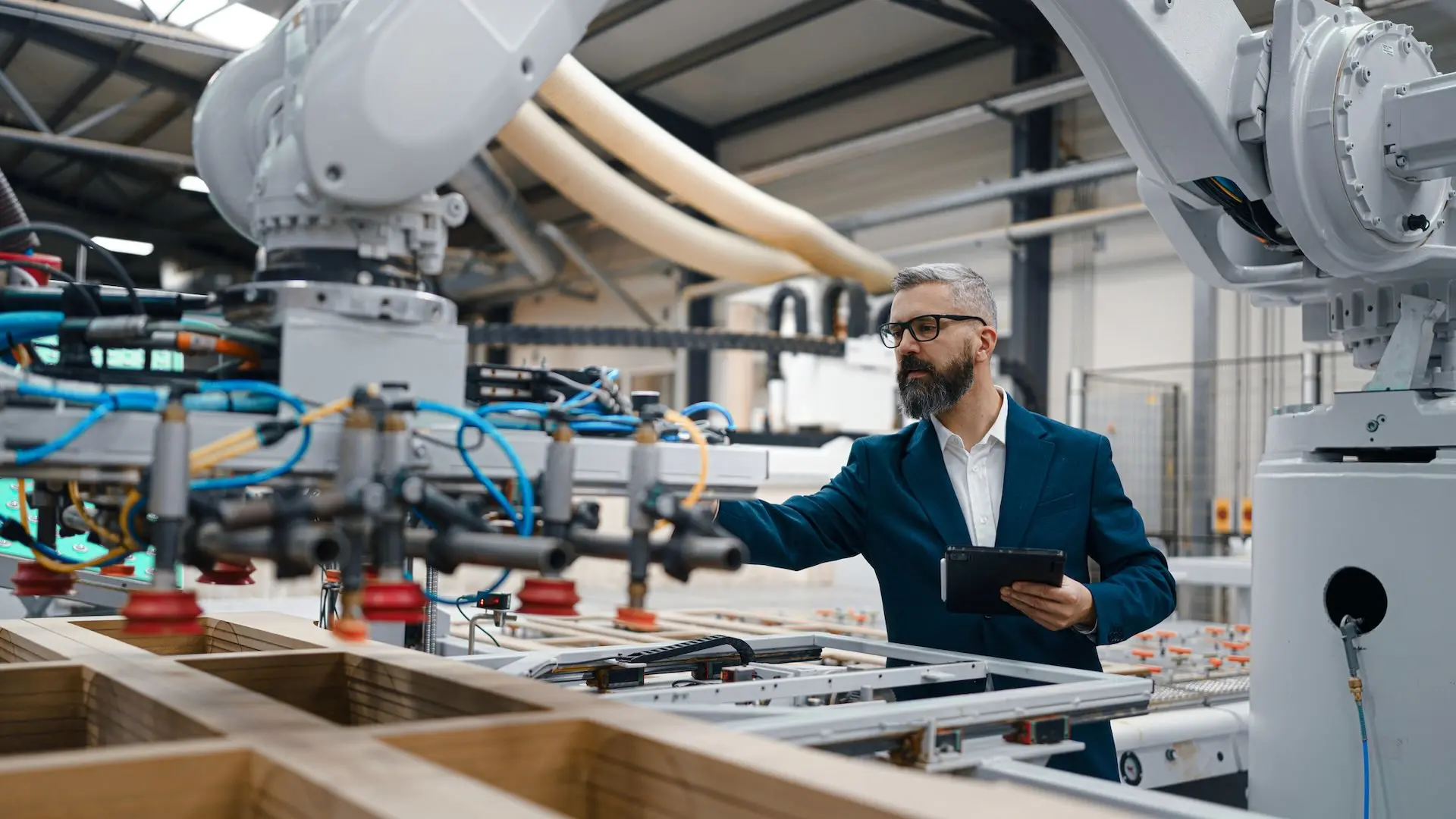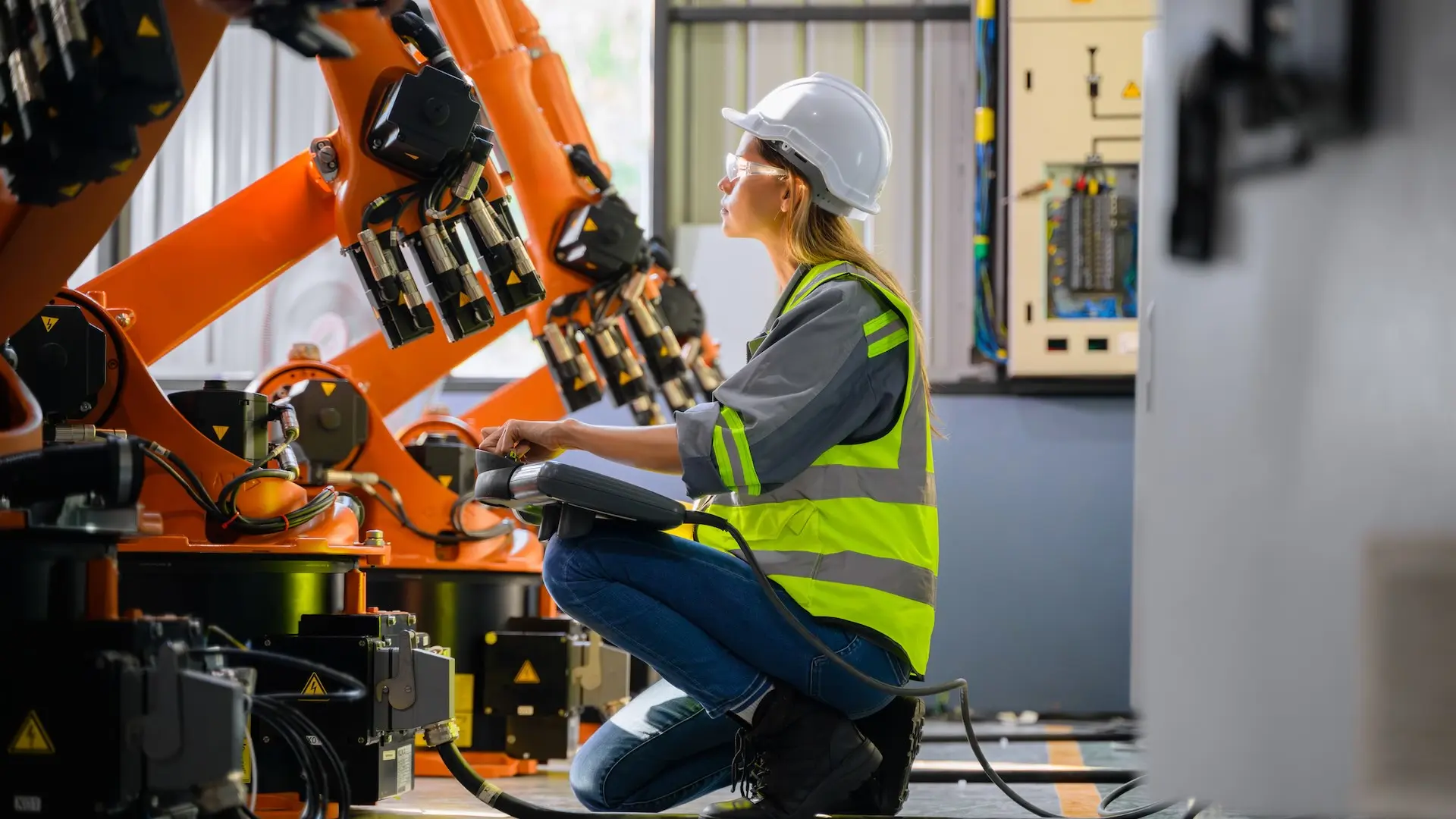& Construction

Integrated BIM tools, including Revit, AutoCAD, and Civil 3D
& Manufacturing

Professional CAD/CAM tools built on Inventor and AutoCAD
First used in the 1960s, industrial robots in manufacturing have become more widespread during the automation age—the increasing digitization of the economy due to the COVID-19 pandemic sent numbers even higher. In 2023 alone over 540,000 industrial robots were newly installed worldwide, bringing the total operational stock of industrial robots to more than 4 million.
Today, industrial robots are widely used across the manufacturing and logistics sectors, with early adoption in the construction industry. These robots are enabling enterprises to carry out work at larger scales and standardize many processes of the new global economy.
Industrial robotics in manufacturing are automated, programmable machines that carry out industrial tasks like pick and place, welding, gluing, inspection, and more using a series of actions on an object or workflow.
These actions are repeated on an indefinite number of units in high-volume, low-mix tasks, and because robots don’t get bored or tired, every action is as detailed and accurate as the first. Industrial robots are also finding use in low-volume, high-mix tasks where they may perform slightly different operations every time, using intelligent software and sensors like cameras and lasers to adjust what they are doing.
The most commonly used types of industrial robots include:
An acronym for “selective compliance assembly robot arm,” a SCARA robot’s four-axis arm has stiff joints in three axes but is compliant in the fourth—which is what makes it “selective.”
SCARA robots are very fast and precise and often used in pick and place applications in industries like electronics manufacturing or food.
Articulated robots provide a full range of motion and workspace compared to a SCARA, using 4, 5 or 6 axes. They are among the most common types of industrial robots with applications in almost every domain ranging from manufacturing to logistics, to food and agriculture. If you’ve seen videos of a robot welding cars in an auto factory or picking boxes in a warehouse, it is most likely an articulated robot.
A cylindrical robot has either a single or articulated arm extending from a rotating base, giving it access to the entire field that’s within range of the effector, the device allowing the robot to interact with its task. If you’ve ever seen a robot pick something up from a surface or belt, rotate in place, and put it down somewhere else, this was likely a cylindrical robot.
Named after the letter of the Greek alphabet it looks like, the delta robot’s arms point downward, converging at the effector and looking like an upside-down triangle. It’s suspended over the work area with the effector accessing the structure or surface below.
Traditionally not as strong as larger industrial robots, the delta robot is more suited to small, light, and precise pick and place operations that don’t involve heavy components, such as foodstuffs or pharmaceutical packaging.
Large robots that move through programmed actions quickly pose inherent safety risks to people in their environment. To address these risks, cobots (collaborative robots) are designed to work alongside human colleagues.
Cobots are often kept to a certain size and speed so they can’t cause serious damage or injury, but programming can also enact hard stops when a human comes in contact with the robot. That also makes them a natural fit for learning, with AI that trains the robot to work on difficult problems.
Mobile industrial robots are wheeled robot bases used to move material around in factories and warehouses. Some robots (called AGVs or automated guided vehicles) follow fixed paths using embedded wires in the floor but recent advances have enabled robots to move more freely. Autonomous mobile robots or AMRs have maps of the building and can be used to autonomously move parts around. AMRs use sensors including cameras and lasers to stop safely if there are people in the way.
As in countless other sectors, AI is having an enormous impact on industrial robotics. Previous-generation robots were programmed, activated, and somewhat forgotten. Humans designed workflows and deployed stations where robots performed their part of a process innumerable times as inputs arrived.
Today, manufacturers are trying to give industrial robots a wider job description in industrial processes. Given enough training data, a robot can carry out more tasks by itself, applying machine learning to novel or changed circumstances to further expand its skillset. Training data provided by other processes and its own historical performance can constantly streamline operations—all without input by a human.
Digital technologies like 3D design and 3D printing are also putting industrial robotics in the hands of ever-smaller businesses and operations. Such democratization will expand the field, encourage innovation from nimbler players, and improve performance and uptake overall.
Robots are also part of the Industrial Internet of Things (IIoT), a field expected to grow by 23% annually until 2030.
As industrial robots (along with countless other physical processes and measurements) are more closely connected to systems along the supply chain—including the ever-larger datasets used as AI training data—securing the industrial robotics ecosystem will become even more crucial.
Companies and organizations around the world are tapping into the many benefits industrial robotics offer:
Because buildings are bespoke and no two bricklaying jobs are the same, this aspect of construction is still done by hand well into the digital age.
But Australian construction company FBR realized bricklaying was actually the perfect task for a robot. With a building plan represented digitally in 3D, a computer can see exactly where the next brick needs to be applied—a task that a robot can do much more accurately than a human.
As a result, FBR created HadrianX, a pick-and-place robot mounted on the back of a vehicle that lays bricks autonomously. The process is faster and the data underlying the construction means the project manager knows exactly how many bricks and how much adhesive will be needed, reducing waste.
The stereotypical case for robots building things is a factory line producing tens of thousands of toys, cars, or computers. A smaller market that requires precision can be a challenge with robotics because far lower output means improvements can be made more often, sending designers back to square one and requiring reprogramming of the robots.
That was the challenge facing Danish wind turbine blade manufacturer Odico. Attaching a 12-ton windmill blade to a turbine requires meticulous precision in the placement, angle, tensile strength, and depth of the connecting apparatus. Odico developed the Drill Mate robot to repeatedly drill precision patterns and to retain and redeploy the strict parameters used even when the design is changed from the ground up.
Some of the benefits of industrial robotics haven’t changed much in over 50 years—they can do dull, dangerous, and dirty work better, faster, and more consistently than humans. But today, automation is supercharging them.
Contrary to the common doomsaying that robots and AI will take peoples’ jobs, industrial robots are helping produce more stuff faster and better with the same resources (both human and material). This increased automation will allow human workers to move up the chain of command, into positions of creative fleet management.
With the increased use of precision industrial robots, the consistency and quality of products will also improve. Industrial robots will be able to handle ever finer and more detailed tasks, and when combined with tools like generative design, designs will be stronger, last longer, and perform better.
As people work alongside robots more, their collaboration will provide a growing dataset for machine learning to constantly improve performance. This will produce a better end result and also a more assured in-process collaboration style that prioritizes worker safety.
Before the pandemic pushed global society further into the world of automation, the numbers were in, and the elements of smart manufacturing (of which industrial robotics are a pivotal part) were enabling real cost savings. A 2019 study saw increases of 10% in production output, 11% in capacity usage, and 12% in labor productivity as a result of smart manufacturing technology. These increases can lead, in turn, to improvements in companies’ bottom lines.
Industrial robotics generate and collect vast datasets as part of the Industrial Internet of Things. When the performance and status of every component and every step of every process can be represented digitally, analytic tools can be applied to get that data to tell multiple stories.
This can reveal how machinery is performing, whether the technology ROI is paying off, which tools need repairing or replacing, and much more. Connecting this data with data in other domains like supplier or sales systems can provide an accurate, constantly updated view of a company’s market position.
Manufacturing or construction workers once got covered in grease and sawdust, smelled like paint or oil, and suffered injuries or maladies common to their fields. Industrial robots in an automated workflow can shift human jobs from these often dangerous roles to new positions that connect workers’ know-how with the visibility analytics AI can provide. Human workers are increasingly designing, implementing, and managing robotics workflows that do the hard stuff while they use their human creativity and experience to make the business better.
Despite the many benefits, robots aren’t cheap or easy to install within a workflow, and getting industrial robotics wrong might cost more than it saves. Some common pitfalls for businesses include:
The price tag of a robot on the showroom floor often won’t include integration management or other tools to situate it neatly into your workflow.
Beyond that, small changes to your line or your suppliers’ standards might reveal hidden areas that need more future-proofing. This might mean that more than just new software or effectors are needed, leading to lost revenue while the operation is offline to make the changes.
Almost every industrial robot manufacturer has their standards, which often only suit the sector they’re active in. Whether it’s the analytics tool that reports on efficiency and performance or a required new effector that doesn’t fit on your hardware, there might be even more unseen costs.
Your robot won’t operate in a vacuum, and servicing or upgrades to augment your processes are seldom free. A robot can save money eventually, but even if the energy cost of running it is taken into account, expecting it to pay for itself is a long-term investment.
For all the upsides, robots aren’t as adaptable as other actors in manufacturing (like humans). When you introduce a new product or workflow shift, humans only need to learn what’s changed. Robots require reprogramming or rebuilding, which takes time, expertise, and expense. The more integral the robot is to a process, the more reprogramming it will cost in dollars and delays.
Industrial robotics is moving away from a program-once-and-forget model. Because they can connect to every other system, device, and platform in the company—and sometimes the whole supply chain—the aim is for robots to use data to drive themselves.
In the future, robots will be able to use information from across their network—from signal readings monitoring their inner workings to sales and marketing data—to make informed decisions and self-direct changes to perform better. As a result, human managers will be able to issue business goals at a conceptual level without having to program every device and tool to execute them.
Algorithms using live, constantly updated training data will reduce downtime, alert managers to a fault or chokepoint before it happens, or use computer vision to inspect and find defects with far more detail than human testers.
Factory owners or project managers can model a workflow digitally to create an exact digital twin that’s constantly updated with live data. Machine learning can then suggest improvements to software, connectivity, the physical location of workflow elements, and much more.
In fact, AI can help model the perfect workflow before a project even starts. Generative design is the methodology where a human designer or manager inputs parameters about performance into the algorithm, then asks it to produce multiple designs that satisfy the criteria.
Industrial robotics are a critical part of the Industrial Internet of Things (IIoT)—they’re where the rubber meets the road, physically producing a deliverable and providing the best chance to interrogate how it’s performing.
While they build, finish, action, or package tools, products, or topologies, industrial robots will be able to provide data on how to deliver what customers expect. That data will be fed back into the IIoT landscape of the organization, so signal readings from devices and systems across the company can present a bird’s eye view of how every process and department is shaping up.
And the IIoT is improving robotics overall. Taking readings on everything in the system, from conveyor belts to the product coming down the line, an industrial robot system can collect and synthesize readings on itself. That means it can offer productivity insights about the process as a whole, as well as its own operation.
This can mean anything from forecast data about a glut of products in the market, prompting production to slow things down, to a robot sending a notification reading “Hey, my secondary belt is getting a little worn. Why not replace it during the next downtime?”
The automation digital technology offers is making waves at every stage of manufacturing.
Just one example is rapid prototyping, enabled by generative design and additive manufacturing, a methodology just as applicable to startup and SMB operations as it is to global-scale manufacturing multinationals.
Concepting a topology (or part of one) as the basis for a device, tool, or component costs little more than the computing power to do so, with generative design giving project managers many possible iterations to select from.
Testing a design under real-world conditions has become as easy as sending the digital file to a 3D printer, and producing a prototype managers can test against as many performance criteria as necessary—even making a different structure for each criterion if need be.
Once again tapping into the power of the Industrial Internet of Things, the digital design can be finessed depending on the metrics it needs to meet. And when it’s ready for production, the same file can be a single source of truth across the workflow, sent to an industrial robotics environment to be created exactly as intended throughout prototyping.
The future of industrial robotics can be summed up in one word: automation.
Robots will be more connected to operating ecosystems as part of a data landscape constantly reporting on their own performance and—especially in the AI age—correcting problems and finding efficiencies. The robots and algorithms that drive them will establish their place in the system by responding to the business aims, more informed by data coming in from the entire supply chain.
This means tomorrow’s manufacturing or industrial worker will have a different role. They’ll need experience with the way robots work and the position they occupy in a factory workflow. But when humans design and construct new manufacturing functions (or repurpose existing ones), they won’t simply be machinists or operators—by definition, they’ll be managers.
Humans will design, control, and outline the overall view of what industrial robots and their connected technologies will need to accomplish using creative problem-solving. The human skills that will be in demand in the future aren’t just technical or physical. Factory workers will be systems engineers and managers, they’ll need to speak the language of data analytics and algorithms, and business owners and operators need to prepare for that world by investing in appropriate training now or be left behind.
This article has been updated. It originally published in September 2018. Mark Smith contributed to the article.
After growing up knowing he wanted to change the world, Drew Turney realized it was easier to write about other people changing it instead. He writes about technology, cinema, science, books, and more.
Emerging Tech
Emerging Tech
Emerging Tech















